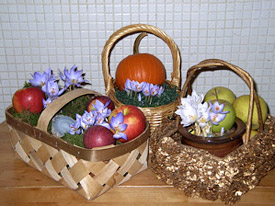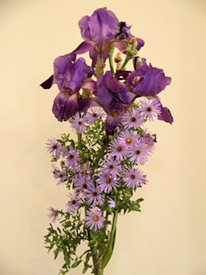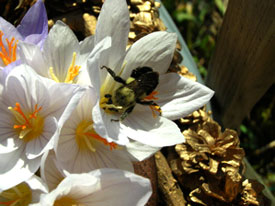
Cold weather has hit most of the country and some areas already have snow cover. People have retreated inside, and even gardeners often neglect to stroll outdoors and look around. It's unfortunate because many people miss nature's final fling. The end of the season can be as dramatic and interesting as the beginning. The Thanksgiving table is a perfect place to celebrate the past growing season and display the garden's last hurrah.
You can create a Thanksgiving centerpiece that celebrates nature and your garden's bounty. For those in mild climates, you have lots of fall-blooming plants to choose from. In San Diego there are as many or more plants flowering in November as in July. But those of us in cold climates have more limited options. As long as there has not been a hard frost below 28 degrees F, some perennials can survive to finish their show.

Asters (Aster oblongifolius 'Raydon's Favorite' and others) reblooming iris (Iris cultivars), monkshood (Aconitum carmichaelii 'Barker's Variety'), gold-and-silver chrysanthemum (Chrysanthemum pacificum), swamp sunflower (Helianthus angustifolius cultivars), and Kamchatka bugbane (Actaea simplex) are some of the hardier late-autumn perennials for temperate zones.
Fall bulbs like Guernsey lily (Nerine) and autumn crocus (Crocus spp.) add bursts of color. A patch of autumn crocuses poking up through fallen leaves brings as much joy in November as Tommy crocuses do when they burst through the snow in March. Witch hazels are just beginning to burst open with their tiny, yellow, aromatic ribbons. Any of these flowers can brighten the Thanksgiving table. Combining them together can make startlingly incongruous arrangements, like chrysanthemums and crocuses in a short bud vase, or asters and iris in a long, tapered vessel.
If the cold has put an end to fresh flowers from the garden, there is still a lot of beauty in nature. The seed heads of prairie grasses, coneflowers, and hydrangeas make decorative dry arrangements. Branches from fruiting shrubs and vines, such as bittersweet, winterberry, chokeberry, and holly, add color and texture. Lotus pods, pinecones, pumpkins, and gourds capture the essence and are naturally ornamental. These can be placed throughout the dining area for a thematic decorating scheme. (Be sure to keep ornamental berries away from small children.)

For those without access to natural materials, blooming houseplants are great substitutes. Amaryllis, cyclamen, African violets, kalanchoe, cineraria, phalaenopsis, and other plants with brilliant flowers and attractive foliage are available in garden centers. Use them alone or combine them in decorative baskets and containers. They can serve double duty as both adornments and gifts for guests.
If you followed the advice from my August Tip #2, you now have pots of autumn crocuses ready to bloom. Leave the crocuses outside until you are ready to display them. Then take them back outside once the turkey has been cleared from the table. On a sunny day or inside a warm house, the flowers will open wide and emit a sweet, honey-like fragrance. They are like sirens to bumblebees.
A couple of years ago when I brought the crocuses in for Thanksgiving, a big queen bumblebee tagged along! All she wanted was the crocus nectar, and she didn't care where she had to go to get it. She had no interest at all in the rolls, cakes, or even us. The bumblebee was solely focused on the flowers and even prodding could not remove her. I literally had to push her into a napkin and take her back outside. As for the crocuses, after you and the bees have enjoyed their show at Thanksgiving, plant them in a sheltered spot that receives full sun.
Thanksgiving is a time to appreciate your health, family, and opportunities. Sitting together around the dinner table reinforces familial ties and strengthens us socially and spiritually. Why not invite nature to the party. Late-autumn elements add the beauty of the season to your family gathering. So be creative and enjoy the celebration.